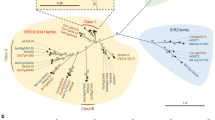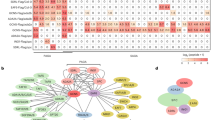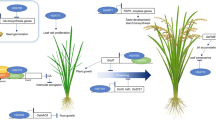Abstract
In eukaryotes, histone acetyltransferases regulate the acetylation of histones and transcription factors, affecting chromatin structural organization, transcriptional regulation, and gene activation. To assess the role of HAC1, a gene encoding for a histone acetyltransferase in Medicago truncatula, stable transgenic lines with modified HAC1 expression in the model plants M. truncatula, Lotus japonicus, and Arabidopsis thaliana were generated by Agrobacterium-mediated transformation and used for functional analyses. Histochemical, transcriptional, flow cytometric, and morphological analyses demonstrated the involvement of HAC1 in plant growth and development, responses to internal stimuli, and cell cycle progression. Expression patterns of a reporter gene encoding beta-glucuronidase (GUS) fused to the HAC1 promoter sequence were associated with young tissues comprised of actively dividing cells in different plant organs. The green fluorescent protein (GFP) signal, driven by the HAC1 promoter, was detected in the nuclei and cytoplasm of root cells. Transgenic lines with HAC1 overexpression and knockdown showed a wide range of phenotypic deviations and developmental abnormalities, which provided lines of evidence for the role of HAC1 in plant development. Synchronization of A. thaliana root tips in a line with HAC1 knockdown showed the involvement of this gene in the acetylation of two core histones during S phase of the plant cell cycle.











Similar content being viewed by others
References
Aggarwal BB, Sung B (2008) Pharmacological basis for the role of curcumin in chronic diseases: an age-old spice with modern targets. Trends Pharmacol Sci 30:85–94
Aggarwal BB, Sung B (2009) Pharmacological basis for the role of curcumin in chronic diseases: an age-old spice with modern targets. Trends Pharmacol Sci 30:85–94
Amasino RM (2005) Vernalization and flowering time. Curr Opin Biotechnol 16:154–158
Ausin I, Alonso-Blanco C, Jarillo JA, Ruiz-Garcia L, Martinez-Zapater JM (2004) Regulation of flowering time by FVE, a retinoblastoma-associated protein. Nat Genet 36:162–166
Bertrand C, Bergounioux C, Domenichini S, Delarue M, Zhou DX (2003) Arabidopsis histone acetyltransferase AtGCN5 regulates the floral meristem activity through the WUSCHEL/AGAMOUS pathway. J Biol Chem 278:28246–28251
Bertrand C, Benhamed M, Li YF, Ayadi M, Lemonnier G, Renou JP, Delarue M, Zhou DX (2005) Arabidopsis HAF2 gene encoding TATA-binding protein (TBP)-associated factor TAF1, is required to integrate light signals to regulate gene expression and growth. J Biol Chem 280:1465–1473
Bordoli L, Netsch M, Luthi U, Lutz W, Eckner R (2001) Plant orthologs of p300/CBP: conservation of a core domain in metazoan p300/CBP acetyltransferase-related proteins. Nucleic Acids Res 29:589–597
Boycheva I, Vassileva V, Iantcheva A (2014) Histone acetyltransferases in plant development and plasticity. Curr Genomics 15:28–37
Brownell JE, Allis CD (1996) Special HATs for special occasions: linking histone acetylation to chromatin assembly and gene activation. Curr Opin Genet Dev 6:176–184
Cemanovic A, Šutković J, Elamawi R, Elkhoby W, Gawwad MRA (2014) 3D structure prediction of histone acetyltransferase (HAC) proteins of the p300/CBP family and their interactome in Arabidopsis thaliana. Netw Biol 4:109–122
Chabaud M, Larsonneau C, Marmouget C, Huguet T (1996) Transformation of barrel medics (Medicago truncatula Gaetrn.) by Agrobacterium tumefaciens and regeneration via somatic embryogenesis of transgenic plants with the MtENOD 12 nodulin promoter fused to gus reporter gene. Plant Cell Rep 15:305–310
Choudhuri T, Pal S, Das T, Sa G (2005) Curcumin selectively induces apoptosis in deregulated Cyclin D1-expressed cells at G2 phase of cell cycle in a p53-dependent manner. J Biol Chem 280:20059–20068
Clough SJ, Bent AF (1998) Floral dip: a simplified method for Agrobacterium-mediated transformation of Arabidopsis thaliana. Plant J 16:735–743
Cools T, Iantcheva A, Maes S, Van den Daele H, De Veylder L (2010) A replication stress-induced synchronization method for Arabidopsis thaliana root meristems. Plant J 64:718–727
Deng WW, Liu CY, Pei YX, Deng X, Niu LF, Cao XF (2007) Involvement of the histone acetyltransferase AtHAC1 in the regulation of flowering time via repression of FLOWERING LOCUS C in Arabidopsis. Plant Physiol 143:1660–1668
d’Erfurth I, Cosson V, Eschstruth A, Lucas H, Kondorosi A, Ratet P (2003) Efficient transposition of the Tnt1 tobacco retrotransposon in the model legume Medicago truncatula. Plant J 34:95–106
Eamens AL, McHale M, Waterhouse PM (2014) The use of artificial microRNA technology to control gene expression in Arabidopsis thaliana. Arabidopsis Protoc 1062:211–224
Fu S, Kurzrock R (2010) Development of curcumin as an epigenetic agent. Cancer 116:4670–4676
Gamborg OL, Miller RA, Ojima O (1968) Nutrient requirements of suspension cultures of soybean root cell. Exp Cell Res 50:151–158
Han S-K, Song J-D, Noh Y-S, Noh B (2007) Role of plant CBP/p300-like genes in the regulation of flowering time. Plant J 49:103–114
He Y, Amasino RM (2005) Role of chromatin modification in flowering-time control. Trends Plant Sci 10:30–35
Hebbes TR, Thorne AW, Crane-Robinson C (1988) A direct link between core histone acetylation and transcriptionally active chromatin. EMBO J 7:1395–1402
Iantcheva A, Chabaud M, Cosson V, Barascud M, Schutz B, Primard-Brisset C, Durand P, Barker DG, Vlahova M, Ratet P (2009) Osmotic shock improves Tnt1 transposition frequency in Medicago truncatula cv Jemalong during in vitro regeneration. Plant Cell Rep 28:1563–1572
Jasencakova I, Meister A, Walter J, Turner B, Schubert I (2000) Histone H4 acetylation of euchromatin and heterochromatin is cell cycle dependent and correlated with replication rather than with transcription. Plant Cell 12:2087–2100
Karimi M, Bleys A, Vanderhaeghen R, Hilson P (2007) Building blocks for plant gene assembly. Plant Physiol 145:1183–1191
Komeda Y (2004) Genetic regulation of time to flower in Arabidopsis thaliana. Annu Rev Plant Biol 55:521–535
Kornberg RD, Lorch Y (1999) Twenty-five years of the nucleosome, fundamental particle of the eukaryote chromosome. Cell 98:285–294
Kuo MH, Allis CD (1998) Roles of histone acetyltransferases and deacetylases in gene regulation. Bioessays 20:615–626
Limpens E, Ramos J, Franken C, Raz V, Compaan B, Franssen H, Bisseling T, Geurts R (2004) RNA interference in Agrobacterium rhizogenes-transformed roots of Arabidopsis and Medicago truncatula. J Exp Bot 55:983–992
Luger K, Mader AW, Richmond RK, Sargent DF, Richmond TJ (1997) Crystal structure of the nucleosome core particle at 2.8 A resolution. Nature 389:251–260
Marcu MG, Jung YJ, Lee S, Chung EJ, Lee MJ, Trepel J, Neckers L (2006) Curcumin is an inhibitor of p300 histone acetyltransferase. Med Chem 2:169–174
Michaels SD, Amasino RM (1999) FLOWERING LOCUS C encodes a novel MADS domain protein that acts as a repressor of flowering. Plant Cell 11:949–956
Mizzen CA, Yang XJ, Kokubo T, Brownell JE, Bannister AJ, Owen-Hughes T (1996) The TAF(II)250 subunit of TFIID has histone acetyltransferase activity. Cell 87:1261–1270
Murashige T, Skoog F (1962) A revised medium for rapid growth and bio assays with tobacco tissue cultures. Physiol Plant 15:473–497
Nolan KE, Rose RJ, Gorst JR (1989) Regeneration of Medicago truncatula from tissue culture: increased somatic embryogenesis using explants from regenerated plants. Plant Cell Rep 8:278–281
Oldroyd GE, Murray JD, Poole PS, Downie JA (2011) The rules of engagement in the legume-rhizobial symbiosis. Annu Rev Gen 45:119–144
Ponting CP, Blake DJ, Davies KE, Kendrick-Jones J, Winder SJ (1996) ZZ and TAZ: new putative zinc fingers in dystrophin and other proteins. Trends Biochem Sci 21:11–13
Revalska M, Vassileva V, Goormachtig S, Van Hautegem T, Ratet P, Ianctheva A (2011) Recent progress in development of a Tnt1 functional genomics platform for the model legumes Medicago truncatula and Lotus japonicus in Bulgaria. Curr Genet 12:147–152
Richards EJ, Elgin SC (2002) Epigenetic codes for heterochromatin formation and silencing: rounding up the usual suspects. Cell 108:489–500
Richmond TJ, Davey CA (2003) The structure of DNA in the nucleosome core. Nature 423:145–150
Roth SY, Denu JM, Allis CD (2001) Histone acetyltransferases. Annu Rev Biochem 70:81–120
Schubert D, Lechtenberg B, Forsbach A, Gils M, Bahadur S, Schmidt R (2004) Silencing in Arabidopsis T-DNA transformants: the predominant role of a gene-specific RNA sensing mechanism versus position effects. Plant Cell 16:2561–2572
Servet C, e Silva NC, Zhou DX (2010) Histone acetyltransferase AtGCN5/HAG1 is a versatile regulator of developmental and inducible gene expression in Arabidopsis. Mol Plant 3:670–677
Sterner DE, Berger SL (2000) Acetylation of histones and transcription-related factors. Microbiol Mol Bio Rev 64:435–459
Sundstrom JF, Nakayama N, Glimelius K, Irish VF (2006) Direct regulation of the floral homeotic APETALA1 gene by APETALA3 and PISTILLATA in Arabidopsis. Plant J 46:593–600
Tadege M, Wen J, He J, Tu H, Kwak Y, Eschstruth A, Cayrel A, Endre G, Zhao PX, Chabaud M, Ratet P, Mysore KS (2008) Large-scale insertional mutagenesis using the Tnt1 retrotransposon in the model legume Medicago truncatula. Plant J 54:335–347
Tian L, Fong MP, Wang JJ, Wei NE, Jiang H, Doerge RW, Chen ZJ (2005) Reversible histone acetylation and deacetylation mediate genome-wide, promoter-dependent and locus-specific changes in gene expression during plant development. Genetics 169:337–345
Vo N, Goodman RH (2000) CREB-binding protein and p300 in transcriptional regulation. J Biol Chem 276:13505–13508
Winter CM, Yamaguchi N, Wu MF, Wagner D (2015) Transcriptional programs regulated by both LEAFY and APETALA1 at the time of flower formation. Physiol Plant 155:55–73
Young ND, Udvardi M (2009) Translating Medicago truncatula genomics to crop legumes. Curr Opin Plant Biol 12:193–201
Young ND, Cannon SB, Sato S, Kim D, Cook DR, Town CD, Roe BA, Tabata S (2005) Sequencing the genespaces of Medicago truncatula and Lotus japonicus. Am Soc Plant Biol 137(4):1174–1181
Acknowledgments
This study was supported by a grant from the National Science Fund of the Ministry of Education and Science of the Republic of Bulgaria, project Do 02-268 (Integrated functional and comparative genomics studies on the model legumes Medicago truncatula and Lotus japonicus, acronym IFCOSMO). The authors are grateful to Kety Krastanova for her valuable technical assistance.
Author information
Authors and Affiliations
Corresponding author
Ethics declarations
Conflict of interest
The authors declare that they have no conflict of interest.
Additional information
Handling Editor: Heiti Paves
Rights and permissions
About this article
Cite this article
Boycheva, I., Vassileva, V., Revalska, M. et al. Different functions of the histone acetyltransferase HAC1 gene traced in the model species Medicago truncatula, Lotus japonicus and Arabidopsis thaliana . Protoplasma 254, 697–711 (2017). https://doi.org/10.1007/s00709-016-0983-x
Received:
Accepted:
Published:
Issue Date:
DOI: https://doi.org/10.1007/s00709-016-0983-x




